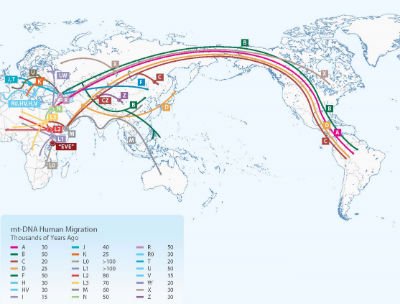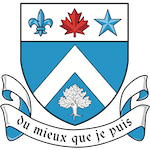Genealogy by DNA
by: Gilles Carmel
 I recently visited ”Search for Adam” a National Geographic Society documentary on the Scientific ADAM also called, EURASIAN.
I recently visited ”Search for Adam” a National Geographic Society documentary on the Scientific ADAM also called, EURASIAN.
This National Geographic Society documentary presents Dr. Spencer Wells’ research project titled: Genographic Project. The objective of his study was to trace the migratory passage of man based on DNA analysis of individuals on a world wide basis.
For geneticists, Scientific Adam, is the common ancestor for all people. There are sequences in the Y chromosome that permit going back to man’s most primitive origins. In our genes we have the history of all our ancestors. They have found for the EURASIANS (Europe-Asia) a common ancestor. It is the M-168 marker. This Scientific Adam, also called Eurosiatic Adam lived approximately 60,000 years ago and originated in Africa. His descendants migrated from Africa.
DNA studies (DesoxiboNucleic Acid) permitted the categorization of a series of genealogical groups that descend from a common ancestor at a prehistoric moment (M-168). They are the haplogroups. There are two kinds of haplogroups: the haplogroups defining the Y (Y-DNA) chromosome inherited from father to son and those (DNA mt) inherited from the mother. The first is to inform about the agnatic lineage (or patrilinear) and the other, is on the cognatic lineage (matrilinear).
Les haplogroupes Y-ADN sont utilisés pour déterminer si 2 individus ayant le même patronyme descendent bien d’un même ancêtre dans un passé pas trop lointain (3 à 20 générations). On se sert de marqueur STR (Short Tandem Repeat).
The haplogroups Y-DNA are used to determine if two individuals with the same family name are descendants of a same ancestor in the recent pass. (3 to 20 generations. We use the marker STR (Short Tandem Repeat) for this test.
The SNP tests (Single Nucleotide Polymorphism) is to retrace to ancestral origins much further back and to identify ethnic groups to which our ancestors belonged. (For example Celtic, Jewish, Germanic, Slavic etc.)
The R1B is by far the most common haplogroup in Occidental Europe
Note that many Normans are of the haplogroup I. Effectively, Rollon and his Vikings settled in Normandy at the beginning of the 10th century. Negotiations led to the Saint-Clair-sur-Epte treaty in 911. According to Historians, he is the first Duke of Normandy. Many French Canadian families are from the haplogroup I. For example the following family members are of the haplogroup I: Duseau, Amireau, Bélanger, Bouchard, Tessier, Auger, Cantin, Hamel, Lacroix etc. Many Normands are of the haplogroup I.
For those wanting more information on the geographic distribution of the ethnic origins of halpogroups check:
- http://www.eupedia.com/europe/origines_haplogroupes_europe.shtml
- http://en.wikipedia.org/wiki/Haplogroup_I1_(Y-DNA)
The Board of directors of the Levasseur Association has decided to capitalize on this scientific discovery and to undertake a DNA project of the Levasseur French heritage. This decision was taken and ratified at the Association’s Annual meeting in Bécancour on October 3, 2009.
Three volunteers of the Pierre Levasseur lineage and three of the Laurent Levasseur lineage will be participating on these projects.
This DNA French heritage project (DNAFH) is for all those who think they have French ancestors. This project is in operation since May 2005. The results (code name and Family name) are part of a data bank that eventually will become of great importance. In Quebec, Mr. Jacques Beaugrand, a retired scientific researcher, is president of DNAFH and is also a member of the French Canadian Genealogy Society
We met with Mr. Beaugrand in Bromont on November 7, 2009. He will be doing an analysis of the Levasseur DNA test results and the genealogical lineage of six volunteers. Once he has certified that the six volunteers have a common profile, he will proceed with the SNP test to determine our distant ancestral origins (Celtic, Jewish, Germanic Etc)
Mr. Beaugrand has accepted to be the guess speaker at our annual meeting in Sherbrooke in 2011. He will be speaking about genealogy by DNA analysis and the results of his research on the Levasseur family name. . This DNA research on three volunteers of Laurent’s lineage and that of Pierre and Jean should enable us to answer certain questions about the origins of Levasseur descendants.
- Is Laurent a relative of Pierre and Jean Levasseur?
- By what migrations did the original ancestors of Laurent and those of Pierre pass? Is the point of origin is Africa (M-168)? Did they come directly from Africa to France or did they pass by Asia, the Scandinavian Countries, Celtic Countries or Palestine?
- These test will determine the genetic signatures of the Levasseurs and the (Levavasseurs).
The project in Canada is being carried out in association with France. In time, we will be in a position to establish comparisons with Levasseurs living in France. We think that there are many varied groups of Levasseurs in France. The Levasseur Family name is a very common name. In France, there are more than 600,000 different family names and the Levasseur name is in the 495th position in terms of usage
We invite other Levasseur to participate in this project. A large number of participants will provide more points for comparison. These would be useful to determine genealogical links.
Certain Levasseur who have a break in their genealogical link, due to a lack or unavailable official documents, could discover whether they are descendants of Pierre and Jean or from Laurent or possibly another Levasseur lineage. A large number of persons participating in this research will subsequently enable us to retrace a missing genealogical link.
DNA genetic will not modify our data base. Genetic genealogy begins where classical genealogy ends and when there are no more documents to study.
It is important to note that the goal of the DNA project is not to determine whether a specific individual is truly a Levasseur. That is why all tests are anonymous. The only information known is the family name with sample key number.
We therefore hope that this new tool will enable us to learn more about on our origins.

